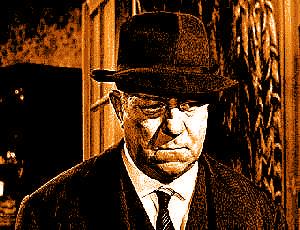Film Review
In the 1950s, American film noir cast a long shadow over French cinema
and was a crucial factor in the establishment of what would become one
of France's most successful film genres for the next few decades, the
film policier. Jacques Becker had started the ball rolling
in 1954 with his seminal crime drama
Touchez pas au grisbi (1954),
closely followed by Jules Dassin's
Du rififi chez les hommes
(1955). The influence of American film noir is very noticeable in
Jean Delannoy's
Maigret tend un
piège, a slick and eerily atmospheric adaptation of a
novel by Georges Simenon. A haunting recurring theme by
Paul Misraki evokes the sleaziness and menace of just about every film
noir you can recall, and hangs in the air like a poisonous mist, luring
us into a dark and dangerous twilight world of criminal malice and
chicanery. The spectre of film noir lingers just
as palpably in much of French cinema of this era.
Comfortably ensconced in the role of the world's most famous fictional detective
bar two (after Sherlock Holmes and Hercule Poirot) is a formidable Jean
Gabin, who positively relishes the part of Maigret and does it justice
with one of his finest post-WWII performances. This was the first
(and by far the best) of Gabin's three outings as Maigret. His
subsequent Maigret films -
Maigret et l'affaire Saint-Fiacre
(1959) and
Maigret voit rouge (1963) - are
comparatively pedestrian, lacking both the artistic flair and dramatic
intensity of
Maigret tend un
piège. It should be noted that Gabin was not the
first French actor to play Maigret. Abel Tarride had first
portrayed the pipe-smoking 'tec in
Le
Chien jaune (1932), followed by Pierre Renoir (
La
Nuit du carrefour, 1932), Harry Baur
La Tête d'un homme, 1933)
and Albert Préjean (
Picpus, 1943).
In the 1990s, Bruno Cremer would claim the part as his own
in a long-running and highly acclaimed series for French television.
Assisting Gabin in his tortuous enquiries is a mouthwatering ensemble
of acting talent that includes rising star Annie Girardot (shortly
before she had her international breakthrough in Visconti's
Rocco and His Brothers) and
established performer Jean Desailly (best known for his role of the
unfaithful husband in Truffaut's
La Peau douce). Lino
Ventura puts in a fleeting appearance (having had a noticeable presence
in several of Gabin's previous films, including
Grisbi) and French film aficionados
will doubtless have fun identifying the cavalcade of character actors
that includes Jean Tissier, Jean Debucourt, Guy Decomble and Paulette
Dubost. Another face to watch out for is Lucienne Bogaert, who is
superb as the main suspect's deliciously warped mother. With such
a distinguished cast, it is hardly surprising that the film was a
substantial box office hit in France, attracting an audience of over
three million.
Jean Delannoy directs the film with his customary panache and keen
visual flair. The nocturnal exterior sequences are a pretty
blatant homage to American film noir, the shadowy setting and use of
off-kilter camera angles adding to the oppressive sense of menace
whilst hinting at the mental derangement that Maigret must grapple with
if he is to solve the mystery. Although much-maligned by the
future directors of the French New Wave, Delannoy was one of most
accomplished and versatile French filmmakers of the 1940s and
50s. His films were stylish, imaginatively crafted, almost
technically flawless and highly popular with mainstream
audiences. Previously, he had directed another superlative noir
drama,
Macao, l'enfer du jeu (1942),
and had collaborated with Jean Cocteau on the classic
L'Éternel
retour (1943). Truffaut et al. may not have rated
Delannoy highly as an auteur, but he brings a very distinctive touch to
most of his films, and he was not afraid to experiment (as he does
here, with some inspired use of the subjective camera) and tackle
controversial subjects (
Chiens perdus sans collier,
Les Amitiés particulières).
Maigret tend un piège
is far from being Delannoy's greatest film, but it is one of his most
entertaining, and easily one of French cinema's most respectable
Simenon adaptations.
© James Travers 2012
The above content is owned by frenchfilms.org and must not be copied.
Next Jean Delannoy film:
Maigret et l'affaire Saint-Fiacre (1959)
Film Synopsis
A mysterious serial killer is at work in the Marais district of
Paris. So far he has claimed the lives of four victims, all
young women, all savagely stabbed to death. Police
superintendent Maigret fears the criminal will strike again but he
hasn't the slightest clue to his identity. Desperate to make a
breakthrough, he conceives a risky plan that may lure the killer into
the open. A false arrest is made just before the latest crime
is reconstructed, and sure enough the killer attacks another
woman. Fortunately, the later has been forewarned and manages to
scare off her attacker. During the police reconstruction,
Inspector Lagrume notices a young woman, Yvonne Maurin, behaving in a
suspicious manner. When Maigret probes her on her strange
behaviour the woman confesses that she has been conducting an illicit
affair with another man and was anxious to keep this from her husband,
a decorator named Marcel Maurin. It transpires that the latter
grew up in a butcher's shop near to where the latest killing took
place, and from which the murder weapon was apparently stolen...
© James Travers
The above content is owned by frenchfilms.org and must not be copied.



